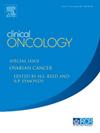立体定向消融放疗治疗罕见原发肿瘤少转移的临床评价。
IF 3
3区 医学
Q2 ONCOLOGY
引用次数: 0
摘要
目的:立体定向消融体放疗(SABR)已成为原发性乳腺癌、前列腺癌、肺癌和结直肠癌等低转移性疾病的一种有前景的治疗方式。然而,关于SABR对罕见原发癌症(rpc)低转移灶的临床结果的信息缺乏。本研究旨在报告治疗结果,并调查哪些因素对RPCs低转移性SABR患者的总生存期(OS)和无进展生存期(PFS)具有预后影响。方法和材料:在同一家机构接受SABR治疗的患者中,所有来自任何rpc的低转移患者都被纳入这项回顾性研究。该队列排除了乳腺癌、前列腺癌、肺癌、结肠癌和直肠原发癌。使用Kaplan-Meier统计计算OS和PFS,并根据不良事件通用术语标准(CTCAE) v. 4.0对sabr后毒性进行评分。基于log-rank检验对OS和PFS的预后因素进行分析,log-rank检验用于分析OS和PFS的预后因素,基于原发肿瘤部位、既往放疗状态、既往全身治疗状态、寡转移灶数量、SABR治疗部位、生物等效剂量、总肿瘤体积大小和计划靶体积(PTV)。结果:114例126例异时性少转移性RPC病变接受SABR治疗。患者接受SABR时的中位年龄为66.7岁(范围:22.3-91.8岁),队列的中位随访时间为21.7个月(范围:2.8-75.8个月)。估计中位OS为40.1个月(95%置信区间[CI]: 27.5-52.6个月),估计中位PFS为14.2个月(95% CI: 11.0-17.5个月)。治疗耐受性良好,大多数患者仅经历1级疲劳,这是最常见的急性毒性。既往放疗状态(P = 0.04)和累计PTV (P = 0.01)是OS的独立预测因子,具有统计学意义。对于PFS, SABR治疗部位(P = 0.03)是唯一具有统计学意义的独立预测因子。结论:关于使用SABR治疗RPC低转移瘤的疗效和治疗后毒性的研究有限。本研究证实,就治疗后毒性而言,SABR是一种安全、无创的治疗选择,适用于RPC源性颅外低转移患者。本文章由计算机程序翻译,如有差异,请以英文原文为准。
Clinical Evaluation of Stereotactic Ablative Radiotherapy for Oligometastases From Rare Primary Cancers
Aims
Stereotactic ablative body radiotherapy (SABR) has emerged as a promising treatment modality for oligometastatic disease from primary breast, prostate, lung, and colorectal cancers. However, there is a paucity of information on clinical outcomes of SABR to oligometastases from rare primary cancers (RPCs). This study aimed to report the treatment outcomes and to investigate what factors are prognostic in terms of overall survival (OS) and progression-free survival (PFS) in patients receiving SABR for oligometastases from RPCs.
Methods and materials
All patients with oligometastases from any RPCs were included in this retrospective review of patients treated with SABR at one single institution. This cohort excluded breast, prostate, lung, colon, and rectum primary cancer. OS and PFS were calculated using Kaplan-Meier statistics and post-SABR toxicities were scored following the Common Terminology Criteria for Adverse Events (CTCAE) v. 4.0. An analysis of prognostic factors for OS and PFS was performed based on log-rank tests which were used for the analysis of prognostic factors for OS and PFS based on the site of primary cancer, previous radiotherapy status, previous systemic therapy status, the number of oligometastases, SABR treatment site, biological equivalent dose, total size of gross tumour volume, and planning target volume (PTV).
Results
A total of 114 patients with 126 metachronous oligometastatic lesions from RPC receiving SABR were included. The median patient age when they received SABR was 66.7 years (range: 22.3-91.8 years), with the median follow-up of the cohort being 21.7 months (range: 2.8-75.8 months). The estimated median OS was 40.1 months (95% confidence interval [CI]: 27.5-52.6 months), and the estimated median PFS was 14.2 months (95% CI: 11.0-17.5 months). The treatment was well tolerated, with the majority of patients experiencing only grade 1 fatigue as the most common acute toxicity. The previous radiotherapy status (P = 0.04) and cumulative PTV (P = 0.01) were identified as statistically significant independent predictors of OS. For PFS, SABR treatment site (P = 0.03) was the only statistically significant independent predictor.
Conclusion
There are limited studies published on the efficacy and post-treatment toxicities of using SABR in the management of oligometastases from RPC. This study confirmed that SABR was a safe, noninvasive treatment option for patients with extracranial oligometastases originated from RPC in terms of the favourable post-treatment toxicities.
求助全文
通过发布文献求助,成功后即可免费获取论文全文。
去求助
来源期刊

Clinical oncology
医学-肿瘤学
CiteScore
5.20
自引率
8.80%
发文量
332
审稿时长
40 days
期刊介绍:
Clinical Oncology is an International cancer journal covering all aspects of the clinical management of cancer patients, reflecting a multidisciplinary approach to therapy. Papers, editorials and reviews are published on all types of malignant disease embracing, pathology, diagnosis and treatment, including radiotherapy, chemotherapy, surgery, combined modality treatment and palliative care. Research and review papers covering epidemiology, radiobiology, radiation physics, tumour biology, and immunology are also published, together with letters to the editor, case reports and book reviews.
 求助内容:
求助内容: 应助结果提醒方式:
应助结果提醒方式:


